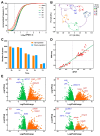Transcriptomic Characterization of Key Factors and Signaling Pathways for the Regeneration of Partially Hepatectomized Liver in Zebrafish
- PMID: 39000319
- PMCID: PMC11241411
- DOI: 10.3390/ijms25137212
Transcriptomic Characterization of Key Factors and Signaling Pathways for the Regeneration of Partially Hepatectomized Liver in Zebrafish
Abstract
Liver regeneration induced by partial hepatectomy (PHx) has attracted intensive research interests due to the great significance for liver resection and transplantation. The zebrafish (Danio rerio) is an excellent model to study liver regeneration. In the fish subjected to PHx (the tip of the ventral lobe was resected), the lost liver mass could be fully regenerated in seven days. However, the regulatory mechanisms underlying the liver regeneration remain largely unknown. In this study, gene expression profiles during the regeneration of PHx-treated liver were explored by RNA sequencing (RNA-seq). The genes responsive to the injury of PHx treatment were identified and classified into different clusters based on the expression profiles. Representative gene ontology (GO) enrichments for the early responsive genes included hormone activity, ribosome biogenesis and rRNA processing, etc., while the late responsive genes were enriched in biological processes such as glutathione metabolic process, antioxidant activity and cellular detoxification. The Kyoto Encyclopedia of Genes and Genomes (KEGG) pathway enrichments were also identified for the differentially expressed genes (DEGs) between the time-series samples and the sham controls. The proteasome was overrepresented by the up-regulated genes at all of the sampling time points. Inhibiting proteasome activity by the application of MG132 to the fish enhanced the expression of Pcna (proliferating cell nuclear antigen), an indicator of hepatocyte proliferation after PHx. Our data provide novel insights into the molecular mechanisms underlying the regeneration of PHx-treated liver.
Keywords: RNA-seq; gene expression; liver regeneration; partial hepatectomy; zebrafish.
Conflict of interest statement
The authors declare that they have no competing interests.
Figures





Similar articles
-
NOD-like receptor signaling pathway activation: A potential mechanism underlying negative effects of benzo(α)pyrene on zebrafish.Comp Biochem Physiol C Toxicol Pharmacol. 2021 Feb;240:108935. doi: 10.1016/j.cbpc.2020.108935. Epub 2020 Nov 5. Comp Biochem Physiol C Toxicol Pharmacol. 2021. PMID: 33161151
-
Transcriptomic characterization of the dorsal lobes after hepatectomy of the ventral lobe in zebrafish.BMC Genomics. 2015 Nov 19;16:979. doi: 10.1186/s12864-015-2145-5. BMC Genomics. 2015. PMID: 26584608 Free PMC article.
-
Progranulin A Promotes Compensatory Hepatocyte Proliferation via HGF/c-Met Signaling after Partial Hepatectomy in Zebrafish.Int J Mol Sci. 2021 Oct 18;22(20):11217. doi: 10.3390/ijms222011217. Int J Mol Sci. 2021. PMID: 34681875 Free PMC article.
-
Inhibition of miR-21 rescues liver regeneration after partial hepatectomy in ethanol-fed rats.Am J Physiol Gastrointest Liver Physiol. 2016 Nov 1;311(5):G794-G806. doi: 10.1152/ajpgi.00292.2016. Epub 2016 Sep 15. Am J Physiol Gastrointest Liver Physiol. 2016. PMID: 27634014 Free PMC article.
-
Using different zebrafish models to explore liver regeneration.Front Cell Dev Biol. 2024 Oct 31;12:1485773. doi: 10.3389/fcell.2024.1485773. eCollection 2024. Front Cell Dev Biol. 2024. PMID: 39544362 Free PMC article. Review.
References
MeSH terms
Substances
Grants and funding
- 2018YFA0800503/National Key R & D Program of China
- 31871463/National Natural Science Foundation of China
- 2021GDASYL-20210102003/Special Fund Project for Guangdong Academy of Sciences to Build Domestic First-class Research Institutions
- 2022GDASZH-2022010202/GDAS' Project of Science and Technology Development
LinkOut - more resources
Full Text Sources
Molecular Biology Databases
Miscellaneous

